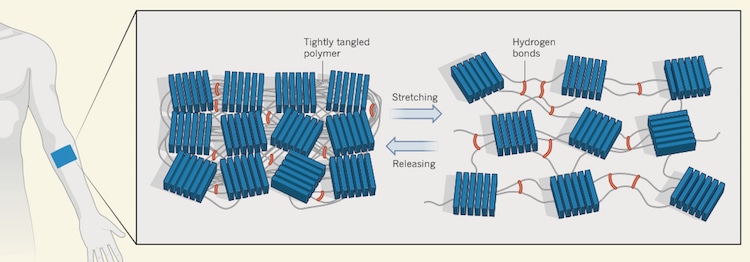Nov 25 2016
Researchers at Stanford University in the US have developed new stretchable and self-healing thin-film polymeric semiconductors. The materials, which contain dynamic intermolecular hydrogen bonds that can be easily broken and reformed, might be used to make advanced organic electronic films that mimic human skin (Nature 539 411).
 Bao and colleagues have prepared a polymer that contains semiconducting crystalline domains (blue) and flexible, amorphous polymer chains crosslinked by hydrogen bonds. When the material is subjected to strain, the chains reversibly elongate and the hydrogen-bond network breaks and re-forms. This allows the material to stretch and unstretch without greatly compromising the semiconducting behaviour. Because broken hydrogen bonds easily re-form, cracks in the bulk material can be healed when heated and treated with solvent vapour. The material was used to make a wearable transistor that tolerated stretching. Courtesy: Nature
Bao and colleagues have prepared a polymer that contains semiconducting crystalline domains (blue) and flexible, amorphous polymer chains crosslinked by hydrogen bonds. When the material is subjected to strain, the chains reversibly elongate and the hydrogen-bond network breaks and re-forms. This allows the material to stretch and unstretch without greatly compromising the semiconducting behaviour. Because broken hydrogen bonds easily re-form, cracks in the bulk material can be healed when heated and treated with solvent vapour. The material was used to make a wearable transistor that tolerated stretching. Courtesy: Nature
Thin-film field-effect transistors are essential elements of stretchable electronics devices for wearable electronics and e-skin, says team leader Zhenan Bao, and all the materials and components making up such transistors need to be stretchable and strong. Until now, researchers mainly focused on materials that can accommodate strain, or on structures like nanofibres and nanowires incorporated into elastomers. However, semiconductors that are inherently stretchable – for example those made from polymers – could be a good option too.
Introducing hydrogen bonds
In their new work, Bao and colleagues used 2,6-pyridine dicarboxamide (PDCA) to introduce hydrogen bonds into the flexible backbone of the semiconducting polymer 3,6-di(thiophen-2-yl)- 2,5-dihydropyrrolo[3,4-c]pyrrole-1,4-dione (or DPP) using supramolecular dynamic chemistry techniques. PDCA contains two amide groups covalently bound together by moderately strong hydrogen bonds that allow the molecules in the DPP to crosslink and form a network. The technique not only makes the DPP more stretchy but also allows electrical charges to travel faster through the material.
"When the polymer is strained, the intermolecular hydrogen bonds are broken, which has the effect of dissipating the strain energy in the material," explains team member Simon Rondeau-Gagne. "This prevents the polymer network from being disrupted (so preventing damage to it). And, although the material cracks when severely elongated, these cracks can be almost completely healed by applying solvent vapour and heat.
Stretchable transistors
"Our polymers retain their electronic properties upon strain," Rondeau-Gagne told our sister site nanotechweb.org. "Indeed, we measured a field-effect mobility of more than 1 square centimetre per volt per second after 500 cycles at 100% applied strain. This is significantly better than previously reported systems."
The researchers fabricated stretchable transistors from their polymers as proof-of-concept devices and found that they had mobilities as high as 1.3 cm2/V/s and a high on/off current of over 106. The field-effect mobility remained as high as 1.12 cm2/V/s even in the direction perpendicular to the 100% applied strain. When placed onto a person's arm or hand like an artificial tattoo, the devices retained their high mobilities when the person moved about normally – that is, twisted his hand, folded his arm or stretched his elbow – so proving that the devices can be employed in wearable electronics.
Future challenges
There are still many challenges to overcome though, says the team. One stumbling block is the high operating voltage (of the order of tens of volts) of the new transistors, point out Siegfried Bauer and Martin Kaltenbrunner of Johannes Kepler University in Linz, Austria, in a related Nature News and Views article (Nature 539 365). This "lowers the energy efficiency of the devices and is thus a concern for autonomously operating wearables", they write. "Smaller voltages will be essential for electronic devices that contact the human body.
"Perhaps the ultimate goal for scientists developing flexible electronics is to produce something that behaves like human skin: the stretchable organ that covers and protects our bodies enables us to feel touch, pain and temperature, and triggers a healing process when wounded," they add. "A perfect technological imitation may not be possible, but [the new] work is a milestone in the search for electronic skins that behave much like their archetype. In the shorter term, healable soft electronic devices hold promise for truly bionic and smart electrical appliances, and might revolutionize future generations of wearables."